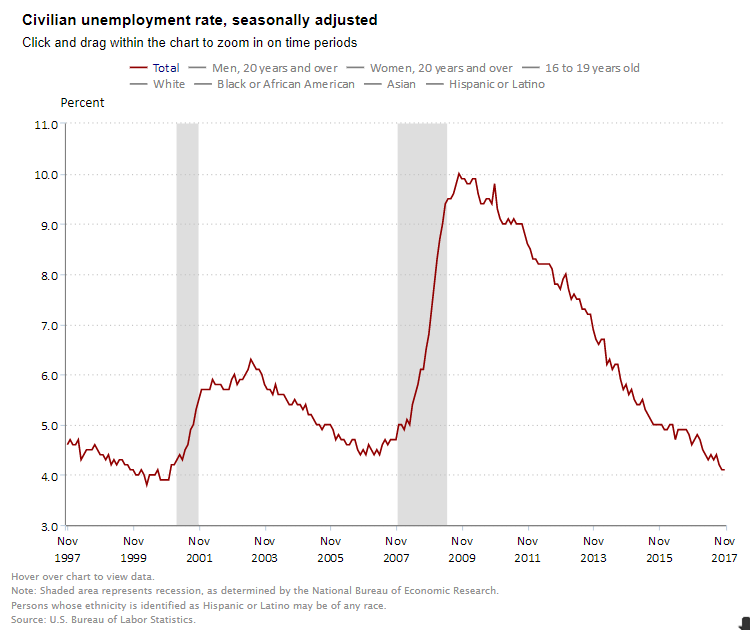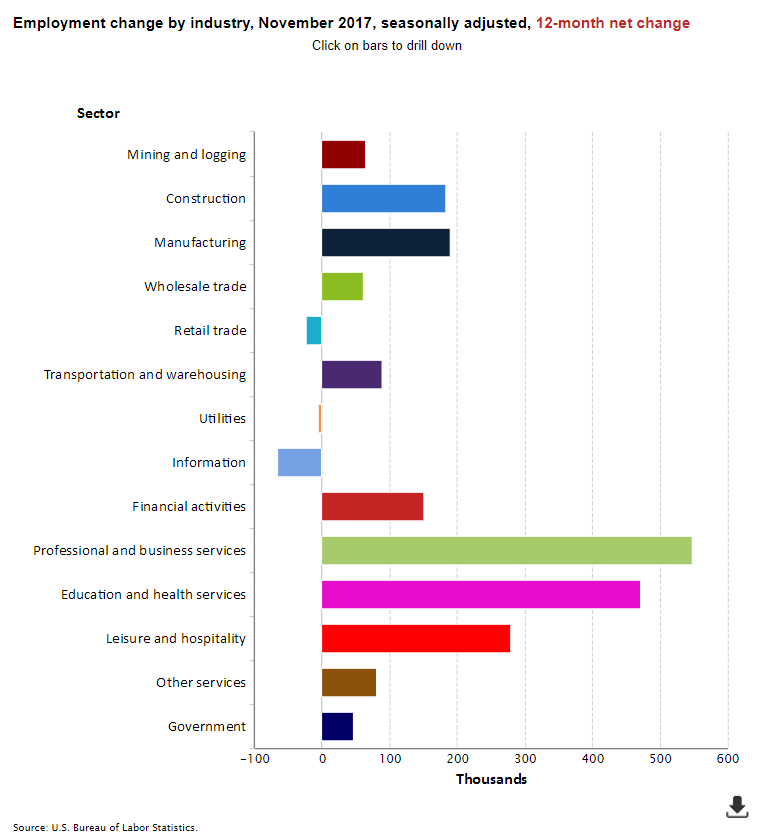The Labor Department reported that there were 228,000 jobs created in the U.S. economy in November. This was above the consensus expectation of 200,000 jobs. This marked the 86th consecutive month of positive job gains for the U.S. economy. Revisions were minimal, adding 3,000 jobs to the prior two months.
Health care added 30,000 jobs in November. Health care has added an average of 24,000 jobs per month thus far in 2017, compared with an average gain of 32,000 per month in 2016.
The unemployment rate remained unchanged at a 17-year low of 4.1% in November. The number of long-term unemployed (those jobless for 27 weeks or more) was little changed at 1.6 million and accounted for 23.8% of the unemployed. Over the year, the number of long-term unemployed was down by 275,000. A broader measure of unemployment, which includes those who are working part time but would prefer full-time jobs and those that they have given up searching—the U-6 unemployment rate—increased to 8.0% in November from 7.9% in October, but was down from 8.6% as recently as August.

The labor force participation rate, which is a measure of the share of working age people who are employed or looking for work remained at 62.7%. This measure has generally been very low by historic standards, at least partially reflecting the effects of retiring baby boomers. The employment-population ratio was little changed at 60.1%.
Average hourly earnings for all employees on private nonfarm payrolls rose in November by five cents to $26.55. Over the past 12 months, average hourly earnings have increased by 64 cents, or 2.5%. This is down from the 2.6% average in 2016. In 2015 this figure was 2.3% and in 2014, it was 2.1%. It is notable that other data suggest stronger wage pressures. The Bureau of Labor Statistics County Employment and Wage Report, which is based on comprehensive tax records, show wage income up 4.7% from year-earlier levels in the second quarter.

Today’s report will support the expected increase in interest rates by the Federal Reserve next week. The Fed has raised rates by a quarter percentage point four times since late 2015, and most recently to a range between 1.0% and 1.25% in June of this year, after keeping them near zero for seven years.
About Beth Mace
Beth Burnham Mace is a special advisor to the National Investment Center for Seniors Housing & Care (NIC) focused exclusively on monitoring and reporting changes in capital markets impacting senior housing and care investments and operations. Mace served as Chief Economist and Director of Research and Analytics during her nine-year tenure on NIC’s leadership team. Before joining the NIC staff in 2014, Mace served on the NIC Board of Directors and chaired its Research Committee. She was also a director at AEW Capital Management and worked in the AEW Research Group for 17 years. Prior to joining AEW, Mace spent 10 years at Standard & Poor’s DRI/McGraw-Hill as director of its Regional Information Service. She also worked as a regional economist at Crocker Bank, and for the National Commission on Air Quality, the Brookings Institution, and Boston Edison. Mace is currently a member of the Institutional Real Estate Americas Editorial Advisory Board. In 2020, Mace was inducted into the McKnight’s Women of Distinction Hall of Honor. In 2014, she was appointed a fellow at the Homer Hoyt Institute and was awarded the title of a “Woman of Influence” in commercial real estate by Real Estate Forum Magazine and Globe Street. Mace earned an undergraduate degree from Mount Holyoke College and a master’s degree from the University of California. She also earned a Certified Business Economist™ designation from the National Association of Business Economists.
Connect with Beth Mace
Read More by Beth Mace